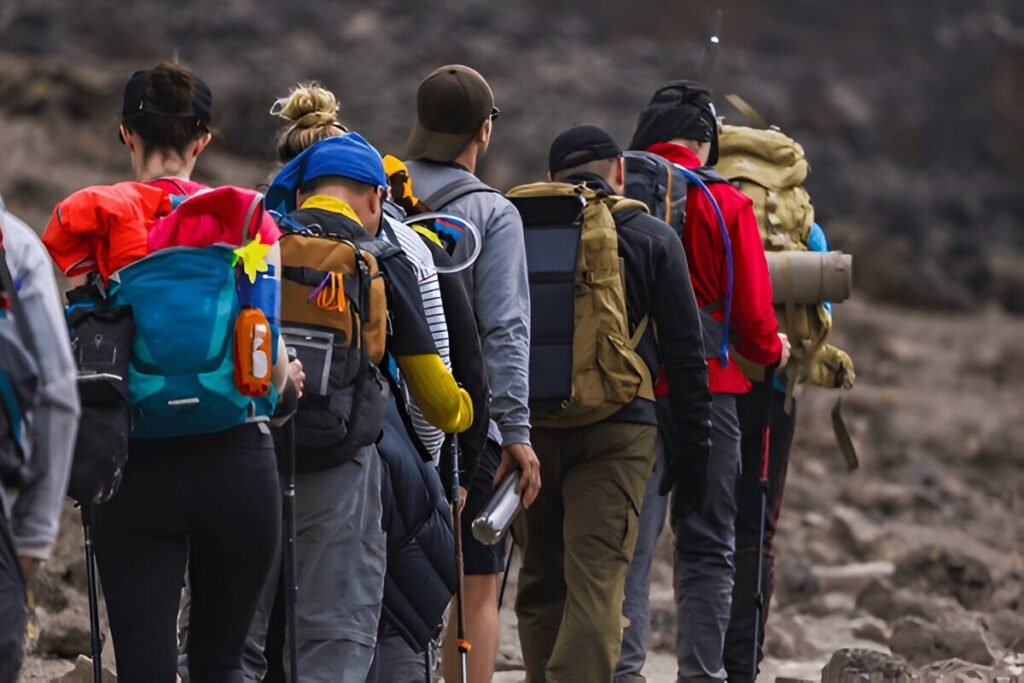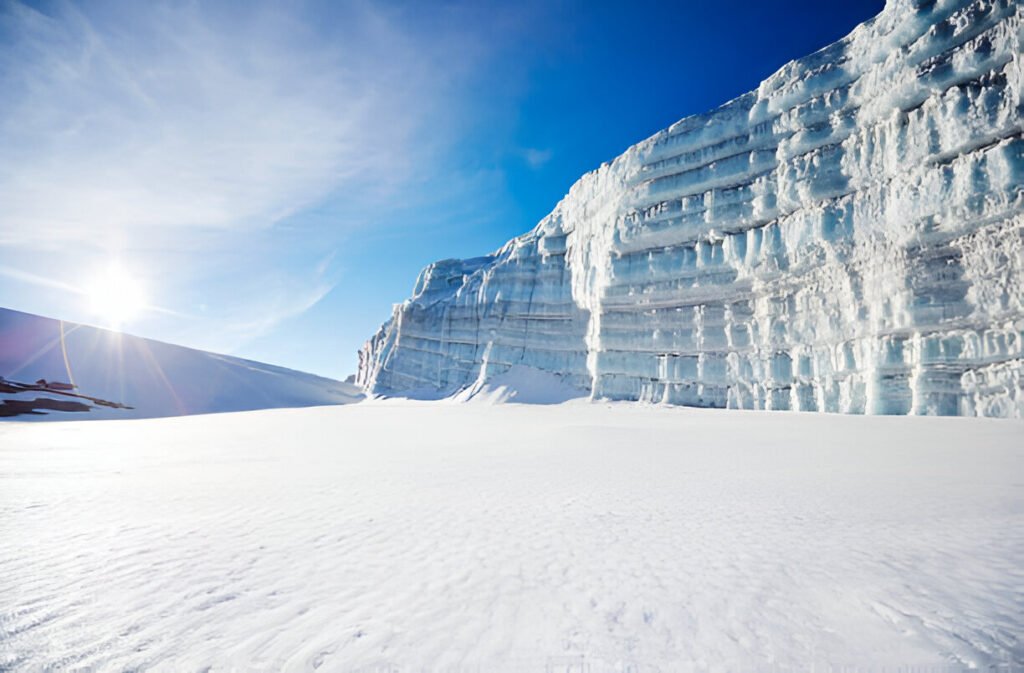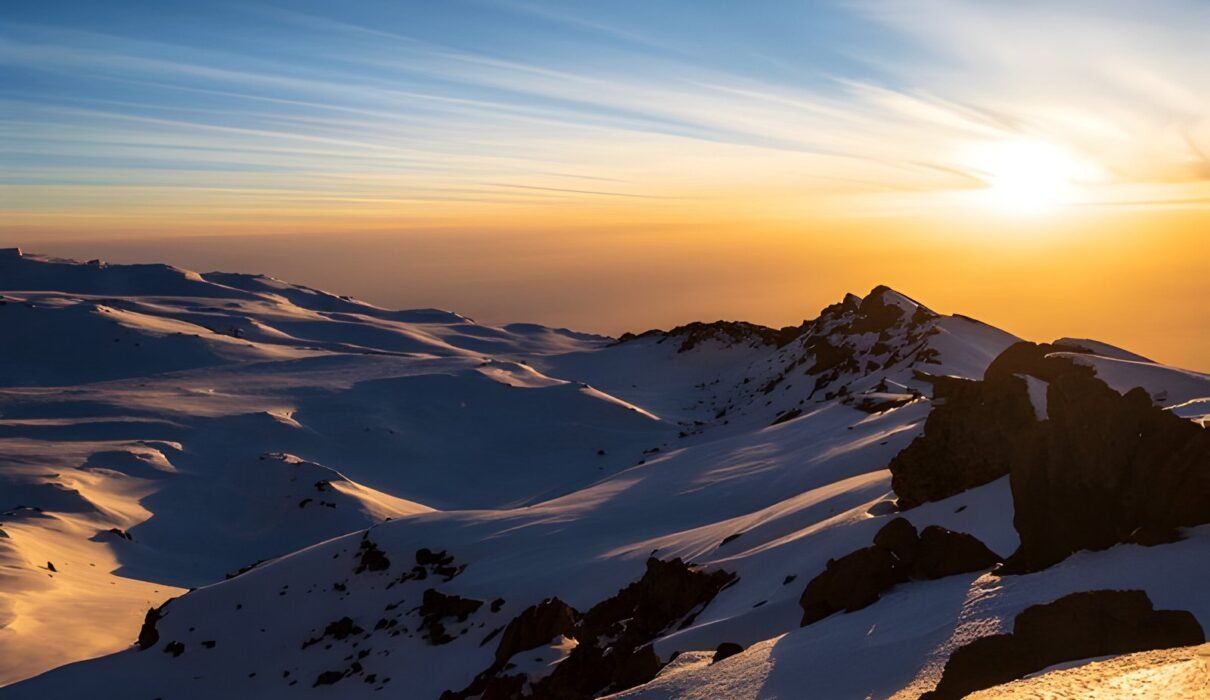The 5-Days Marangu Route Kilimanjaro Climb Quick Summit Trek offers a quick and comfortable way to reach the summit of Mount Kilimanjaro, Africa’s highest peak. Known as the “Coca-Cola Route” because it’s considered easier than other routes, the Marangu Route is the only one that provides hut accommodations rather than camping, making it a popular choice for climbers seeking comfort and a faster trek to the top.
This 5-Days Marangu Route Kilimanjaro Climb Quick Summit Trek is perfect for those short on time but eager to conquer the Roof of Africa. In this guide, we’ll explore what makes the Marangu Route a fantastic choice for a quick Kilimanjaro summit and provide insights into the daily itinerary, what’s included, and how to prepare for your adventure.

Why Choose 5-Days Marangu Route Kilimanjaro Climb Quick Summit Trek?
The Marangu Route is one of the most popular ways to climb Kilimanjaro, especially for first-time trekkers. Here’s why the 5-day trek on this route stands out:
1. Fast and Efficient Ascent, 5-Days Marangu Route Kilimanjaro Climb Quick Summit Trek
The Marangu Route is the fastest way to reach the summit of Kilimanjaro. Over the course of 5 days, you’ll ascend to the top of Uhuru Peak (5,895 meters) and descend back down. This makes it perfect for climbers who are on a tight schedule but still want to experience the thrill of summiting Kilimanjaro.
Learn more about summit success rates and the benefits of fast treks on Kilimanjaro Climb Specialist.
2. Hut Accommodation for Extra Comfort, 5-Days Marangu Route Kilimanjaro Climb Quick Summit Trek
Unlike other Kilimanjaro routes, the Marangu Route offers hut accommodation instead of camping. Each night, you’ll stay in simple A-frame huts, which provide more shelter and comfort, especially during bad weather. This makes the Marangu Route a great option for those who want to avoid the challenges of camping at high altitudes . For more information on the hut accommodations available along the route, check out this Tanzania travel guide.
3. Stunning Scenery Along the Way, 5-Days Marangu Route Kilimanjaro Climb Quick Summit Trek
Despite being the shortest route, the Marangu trek offers diverse landscapes, from lush rainforests at the base to alpine deserts and snowy peaks near the summit. You’ll hike through the Moorland Zone and have the chance to see unique flora and fauna, including colobus monkeys and giant groundsels.
Discover more about the ecosystems of Kilimanjaro on National Geographic’s Kilimanjaro page.
5-Days Marangu Route Kilimanjaro Climb Quick Summit TrekItinerary Day-by-Day Breakdown
Here’s a detailed day-by-day itinerary for your 5-Days Marangu Route Kilimanjaro Climb Quick Summit Trek
Day 1: Marangu Gate to Mandara Hut
- Elevation: 1,870 meters to 2,720 meters
- Hiking Time: 5-6 hours
- Distance: 8 km
Your adventure begins at Marangu Gate, where you’ll register with Kilimanjaro National Park and meet your guides. The trek starts with a hike through the rainforest zone, home to rich biodiversity, including monkeys and colorful birds. After a scenic walk, you’ll arrive at Mandara Hut, where you’ll spend the night.
For more information about the starting point and rainforest, visit Eddy Tours & Safaris.
Day 2: Mandara Hut to Horombo Hut
- Elevation: 2,720 meters to 3,720 meters
- Hiking Time: 6-7 hours
- Distance: 12 km
On day two, you’ll ascend through the Moorland Zone, where the landscape opens up to rolling hills and sweeping views of Mawenzi and Kibo peaks. You’ll reach Horombo Hut in the afternoon, where you can rest and acclimatize.
Learn more about acclimatization and how it helps prevent altitude sickness from WebMD’s altitude sickness guide.
Day 3: Horombo Hut to Kibo Hut, 5-Days Marangu Route Kilimanjaro Climb Quick Summit Trek
- Elevation: 3,720 meters to 4,703 meters
- Hiking Time: 6-7 hours
- Distance: 10 km
Day three takes you through the alpine desert as you trek towards Kibo Hut, the final stop before the summit push. The terrain becomes more challenging as the air thins, but you’ll be rewarded with stunning views and the excitement of being one step closer to the summit.
Day 4: Kibo Hut to Uhuru Peak, Descend to Horombo Hut, 5-Days Marangu Route Kilimanjaro Climb Quick Summit Trek
- Elevation: 4,703 meters to 5,895 meters (summit), descend to 3,720 meters
- Hiking Time: 10-14 hours
- Distance: 22 km
The most challenging and exciting part of your journey begins at midnight, as you start your ascent to Uhuru Peak. After a strenuous climb, you’ll reach the summit of Kilimanjaro, the highest point in Africa, and celebrate your achievement. Following a brief rest, you’ll descend back to Horombo Hut.
For more on what to expect during the summit push, check out this Kilimanjaro summit guide.
Day 5: Horombo Hut to Marangu Gate
- Elevation: 3,720 meters to 1,870 meters
- Hiking Time: 5-6 hours
- Distance: 20 km
On the final day, you’ll descend back to Marangu Gate, where you’ll receive your summit certificate and say goodbye to your guides. A transfer will take you back to Moshi or Arusha, where you can relax and reflect on your achievement.

What’s Included in the 5-Days Marangu Route Kilimanjaro Climb Quick Summit Trek?
This all-inclusive package provides everything you need for a successful and comfortable climb:
1. Professional Guides and Porters, 5-Days Marangu Route Kilimanjaro Climb Quick Summit Trek
Your climb will be led by certified guides, who will ensure your safety and success on the trek. Porters will carry your gear, so you can focus on the climb without the extra weight.
For more about the role of guides and porters, visit Eddy Tours & Safaris.
2. Hut Accommodation, 5-Days Marangu Route Kilimanjaro Climb Quick Summit Trek
As mentioned earlier, the Marangu Route is the only Kilimanjaro route with hut accommodation. You’ll stay in comfortable, communal huts at Mandara, Horombo, and Kibo, which provide a more sheltered experience than camping.
3. Meals and Drinks, 5-Days Marangu Route Kilimanjaro Climb Quick Summit Trek
All meals are provided during the trek, prepared by your camp chef. You’ll enjoy three freshly prepared meals a day, ensuring you stay nourished and energized. Bottled water will also be available throughout the hike.
4. Kilimanjaro National Park Fees, 5-Days Marangu Route Kilimanjaro Climb Quick Summit Trek
All park entry fees, camping fees, and rescue fees are included in your package, so you won’t have to worry about any extra costs during your climb.
To learn more about Kilimanjaro National Park and its regulations, visit Tanzania National Parks Authority (TANAPA).
5. Safety Gear and Equipment, 5-Days Marangu Route Kilimanjaro Climb Quick Summit Trek
Your safety is our priority. The package includes first aid kits, oxygen tanks, and pulse oximeters to monitor your health at high altitudes. Your guides are trained to manage any altitude-related issues that may arise.
How to Prepare for Your 5-Days Marangu Route Kilimanjaro Climb Quick Summit Trek
1. Training for Kilimanjaro
Although the Marangu Route is considered one of the easier routes, climbing Kilimanjaro is still a physically demanding challenge. It’s important to start training a few months in advance, focusing on cardio exercises, strength training, and hiking with a weighted backpack.
For a detailed training plan, check out Kilimanjaro training tips.
2. Packing Essentials, 5-Days Marangu Route Kilimanjaro Climb Quick Summit Trek
Here’s a list of essential gear for your climb:
- Warm clothing layers: Including thermal layers, a fleece jacket, and a down jacket for the summit.
- Sturdy hiking boots: Make sure they’re well broken in.
- Waterproof gear: A jacket and pants to protect against rain and wind.
- Trekking poles: To help with balance and reduce impact on your knees.
- Headlamp: Essential for the midnight summit push.
For a full packing list, visit Ultimate Kilimanjaro’s gear guide.
Frequently Asked Questions (FAQs) on 5-Days Marangu Route Kilimanjaro Climb Quick Summit Trek
1. Is the Marangu Route suitable for beginners?
Yes, the Marangu Route is considered one of the easier routes to the summit of Kilimanjaro, making it a great option for beginners. However, climbers should still be prepared for the physical challenge of high altitude trekking.
2. Do I need prior trekking experience?
No prior trekking experience is required, but it’s recommended to have a good level of physical fitness. Training before your climb will increase your chances of success.
3. What is the success rate for the 5-day Marangu Route?
The success rate for the 5-day Marangu Route is lower compared to longer routes like Lemosho or Machame due to the shorter acclimatization period. However, many climbers still reach the summit with proper preparation.
For more about success rates on Kilimanjaro, visit Kilimanjaro Climb Specialist.
4. What is the best time to climb Kilimanjaro?
The best time to climb Kilimanjaro is during the dry seasons: January to March and June to October. These months offer more stable weather conditions, making for a safer and more enjoyable trek.
For more weather insights, visit BBC Weather’s Kilimanjaro guide.
5. Can I join a group climb on the Marangu Route?
Yes, many climbers choose to join group climbs on the Marangu Route. Group climbs offer a more social experience and are often more affordable.
For more information or to book your 5-Day Marangu Route Kilimanjaro Climb, visit Kilimanjaro Climb Specialist and Eddy Tours & Safaris.

